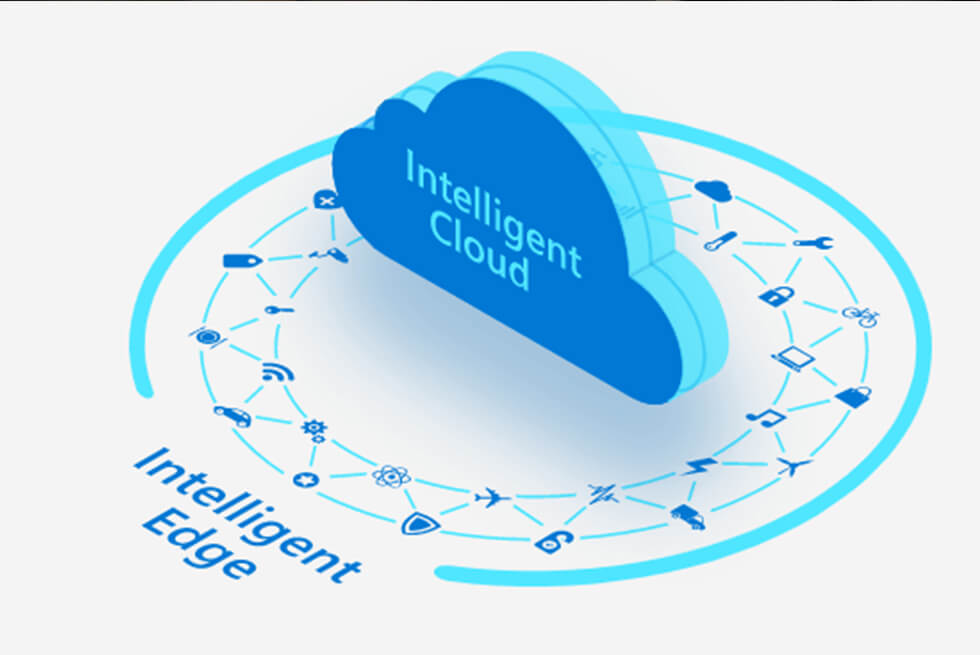Digitalization means that more and more computer-controlled devices and machines can also be found in your company. Under the buzzword “Industry 4.0”, a new form of production is emerging with computerized, highly networked factories and stores controlled by artificial intelligence (AI). This is made possible by three of the most important key technologies of our time: Artificial Intelligence, Intelligent Edge and Cloud Computing.
What is an Intelligent Edge?
The basis for the Intelligent Edge is the so-called “Internet of Things” (IoT). This “Internet of Things” networks everyday objects, machines, mobile computers, sensor systems and much more into an all-encompassing network. There are virtually no limits to the areas of application. Intelligent refrigerators and heating systems in private households are just as possible as automated irrigation systems in agriculture, networked public transportation in the “smart city” or learning production robots and construction machines.
All of these systems produce such large volumes of data that, until now, only powerful servers in external data centers could handle them. But this “cloud computing” is now encountering practical limits. Uploading the generated data to the cloud and downloading control instructions takes time and can be costly for large data volumes.
This is where edge computing comes in. Today’s PCs, mobile computers and microcontrollers are so powerful that they can handle many calculations and data analyses themselves. The English word “edge” means “edge” or “margin”, figuratively also “frontmost front”. Edge computing is about having as much data as possible processed by systems at the edge of the local network or even directly from the IoT device in question. Intelligent edge technology integrates artificial intelligence into sensor systems and edge controllers so that they can act faster, more efficiently and more autonomously.
Advantages of the Intelligent Edge
Edge smart metering and control systems offer many advantages over classic cloud solutions. However, there are also new challenges to consider.
- Speed: Many application areas in the industrial IoT (IIoT) require real-time data processing. For robot controls, measurement technology, human-machine interfaces or autonomous vehicles, among others, the latency or response time must be as low as possible. With an Intelligent Edge, you avoid the time-consuming exchange of data with external cloud systems.
- Scalability: You can add or remove new devices from the Intelligent Edge as needed. However, this also leads to a highly dynamic system with new requirements in areas such as compatibility, IT management and security.
- Availability: For traditional cloud approaches, you need highly stable access to the Internet. Since the Intelligent Edge is much more self-sufficient, failures of individual devices and network connections can be easily bridged.
- Security and data protection: Local data processing makes it easier to limit and control the transfer of potentially sensitive data to external cloud providers. This is complemented by advanced security solutions such as Azure Sphere, which provide Microsoft’s Intelligent Edge with specialized protections.
- Cost control: The Intelligent Edge enables efficient and targeted processing on premise. This allows you to produce faster and reduce tariff costs for cloud services.

From Edge to Cloud – holistic solutions for modern industry
Although edge computing also works well as a standalone solution, its true potential is only revealed in combination with cloud technologies. Intelligent Edge and Intelligent Cloud can be excellently combined. While rapid analytics and real-time controls can be implemented in the edge, the cloud delivers long-term analytics through machine learning and powerful AIs. Added to this are modern user interfaces such as touchscreens and data glasses, with which human operators can monitor the system and control it in a targeted manner.
To help you manage all these components in a user-friendly way, Microsoft has added many Edge features to its Azure cloud service. The most important services include:
- Azure IoT Central is the central intelligence edge platform that lets you set up, manage, and control IoT and edge devices.
- Azure IoT Hub delivers communication services for data exchange between edge and cloud.
- Azure IoT Edge enables moving AI capabilities from the cloud to the edge and is available for Windows and Linux devices.
- Azure Remote Rendering is a cloud service that prepares the data from the Edge as high-resolution and interactive 3D models for the Microsoft data glasses HoloLens 2. Microsoft had already presented its many possibilities at the MWC mobile and intelligent edge conference in 2019.
Conclusion
Whether in logistics companies, farms, factories, utilities, wholesale and retail, or at the university, countless data are generated everywhere in the modern world. The Intelligent Edge enables cost-effective and fast data processing directly on site. Together with cloud services like Microsoft Azure, it creates an Intelligent Edge platform that equips you for the fourth industrial revolution.



Leave A Comment